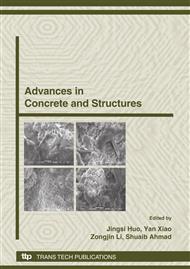p.3
p.17
p.27
p.37
p.43
p.55
p.69
p.81
p.89
A Study on Flexural Performance of RC Beam Strengthened with UHTCC for Improved Durability
Abstract:
Ultra-high toughness cementitious composite (UHTCC) exhibits the pseudo-hardening feature when subjected to tensile load and has high tensile strain capacity of normally up to 3%. Also, UHTCC has a unique cracking behavior. From cracking up to ultimate tensile strain capacity, the crack width in UHTCC could be still kept below 100m. This paper presents the utilization of UHTCC to replace a layer of concrete surrounding the main flexural reinforcement in ordinary RC beam to improve flexural performance especially beam durability as UHTCC displays high toughness and shows multiple fine cracks. Analytical closed-form formulae for flexural capacity, curvature and deformation of UHTCC/RC composite beam derived based on the elastic beam theory is presented first. Subsequently, experimental results of two groups of different reinforcement ratios of UHTCC/RC beams and control RC beams tested under flexural loading to verify the feasibility of analytical formulae as well as to examine the performance improvement of UHTCC/RC composite beam over the control beam is presented. Moment-curvature curves and load-mid span displacement curves for the tested beams are compared with the theoretical analysis. A good agreement between experimental and analytical results is found. The experimental results show that the use of a layer of UHTCC in RC beams can enhance both flexural capacity and ductility. The improvement is not significant with the increase in reinforcement ratio; however, the maximum crack width under service load even in the case of lightly reinforced beams can be limited within 0.1mm.
Info:
Periodical:
Pages:
43-54
Citation:
Online since:
October 2008
Authors:
Price:
Сopyright:
© 2009 Trans Tech Publications Ltd. All Rights Reserved
Share:
Citation:


